|
|
|
Sort Order |
|
|
|
Items / Page
|
|
|
|
|
|
|
| Srl | Item |
| 1 |
ID:
140506


|
|
|
|
|
| Summary/Abstract |
Consumerism is a central feature of urbanism in China and has been actively promoted as a sign of urbanity in the official rhetoric and mass media. This urban ideology is exemplified by the ubiquitous presence of street advertisements that often occupy prominent urban public spaces. After all, turning every citizen of China into a consumer has become a widely accepted Chinese dream and one that is employed to mobilize a population otherwise divided by the ever-widening gap between the rich and poor. Advertisements have assumed a commanding role and are utilized by both official entities and private corporations to promote all kinds of urban consumption, ranging from concrete commodities such as high-end homes, beautiful neighbourhoods, and luxurious goods to intangible symbols such as lifestyle, ideology, and cosmopolitan identity. All these have fallen under the scrutiny of the Shanghainese artist Ni Weihua, whose photography documents billboards advertising official ideologies and real-estate projects in Shanghai and other cities. This study brings into context Ni’s artistic practice and examines specific ways in which his photographic series Keywords (关键词) and Landscape Wall (风景墙) engage with formal advertisements in the street both as an urban reality and as a site for deconstruction.
|
|
|
|
|
|
|
|
|
|
|
|
|
|
|
|
| 2 |
ID:
170746


|
|
|
|
|
| Summary/Abstract |
In 2012, a Chinese developer, Zendai, purchased 1,600 hectares of land in Modderfontein, Johannesburg, and announced plans for a new urban megadevelopment. Hiring a Chinese designer, the company released a series of computer-generated images. Drawing on these, the media and many in the city perceived the site to be distinctly “Chinese,” rooted in futuristic, speculative visions of urbanity. At the same time, African urban research turned its attention to similar large-scale projects throughout the continent, and has continued to speculate on their consequences. Building on these two different interpretations of Modderfontein, this paper engages with the site as a manifestation of both global trends (e.g., increasing Chinese engagement with Africa, urban inter-referencing throughout the Global South) and a reflection of place- and context-specific factors. In doing so, we focus on the ordinariness of the project to interrogate how the idea of creating an ultramodern global economic hub, rooted in the experiences and practices of a Chinese-based developer, was in the end mediated by the actions of international consultants and the City of Johannesburg. We suggest that Modderfontein should be seen as a generative form of urbanism where elements perceived to be Chinese were lost in the master planning process. We argue that the socio-material dimensions of the project instead reflect a distinctly South African urbanism.
|
|
|
|
|
|
|
|
|
|
|
|
|
|
|
|
| 3 |
ID:
122872
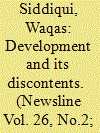

|
|
|
| 4 |
ID:
089443


|
|
|
| 5 |
ID:
152168


|
|
|
|
|
| Summary/Abstract |
In the late 2000s, the phenomenon of ghost cities emerged in China, including not only boomtowns such as Ordos but also “ordinary” third- and fourth-tier cities such as Changzhou. Based on a conceptual framework of China’s land-driven growth machine under entrepreneurial governance, we update the ghost city phenomenon through an in-depth empirical study of a third-tier city, Changzhou. The objective of this paper is to expand our understanding of how excessive accumulation of real estate assets has come to dominate the landscape of this type of city against the background of China’s economic slowdown. The author argues that overbuilding is due to the malfunction of the classic urban expansion model under entrepreneurial governance. In the case of Changzhou, the local government continued massive “sales” of residential and commercial land while effective housing demand was declining due to slowdowns in the local manufacturing industry and in population growth. In response to the “New Normal” advocated by the central government, the government of Changzhou redirected its land and housing policy. Nevertheless, more profound reforms are needed to change the paradigm of growth-oriented urbanism.
|
|
|
|
|
|
|
|
|
|
|
|
|
|
|
|
| 6 |
ID:
105226
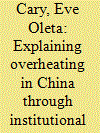

|
|
|
|
|
| Publication |
2011.
|
| Summary/Abstract |
Economic overheating is a significant and recurring problem in modern China. This paper analyzes the many factors causing overheating and argues that there are systemic and largely structural explanations for overheating that arise from a number of theorized catalysts, including a bureaucratic catalyst and a historical catalyst.
|
|
|
|
|
|
|
|
|
|
|
|
|
|
|
|
| 7 |
ID:
120630


|
|
|
|
|
| Publication |
2013.
|
| Summary/Abstract |
Over the past two decades, global market finance has taken root in China to seek property investment. This article examines the spatialities and anchorage methods of finance capital within Chinese national territory. It highlights the spatial and sectoral differences in the composition of property portfolios as a function of the return/risk coupling. These differences are exacerbated by a split in the geographical origin of the funds, which determines differentiated conditions of access to land and management of the investment time horizon of the assets portfolios. The penetration of finance capital into urban space tends to increase the fragmentation and functional specialisation of districts, a phenomenon fostered by entrepreneurial urban policies. As a result, urban projects are becoming standardised in terms of both design and program. They are increasingly governed by external references that favour the expansion of multinationals and transform lifestyles and consumer habits.
|
|
|
|
|
|
|
|
|
|
|
|
|
|
|
|
| 8 |
ID:
152167
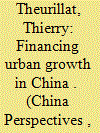

|
|
|
|
|
| Summary/Abstract |
Illustrated by a case study on the urban development of a medium-sized city in China, this article develops a theoretical framework to help understand the role the financial system plays in the urban development model based on land in China. Three fields of literature have been used in order to link the various mechanisms between land, urban infrastructure, property development, and financing channels in urban production. The case study illustrates the many interactions between local government and real estate businesses, both state and private, as well as local banks, in order to create urban infrastructure that responds to “communal and public” needs and real estate objectives of a “private and individual” nature. In doing so, it highlights the fundamental role of capital in urban production in China.
|
|
|
|
|
|
|
|
|
|
|
|
|
|
|
|
| 9 |
ID:
103955


|
|
|
| 10 |
ID:
178479


|
|
|
|
|
| Summary/Abstract |
China's real estate has been a key engine of its sustained economic expansion. This paper argues, however, that even before the COVID-19 shock, a decades-long housing boom had given rise to severe price misalignments and regional supply–demand mismatches, making an adjustment both necessary and inevitable. We make use of newly available and updated data sources to analyze supply–demand conditions in the fast-moving Chinese economy. The imbalances are then compared to benchmarks from other economies. We conclude that the real estate sector is quite vulnerable to a sustained aggregate growth shock, such as COVID-19 might pose. In our baseline calibration, using input–output tables and taking account of the very large footprint of housing construction and real estate related sectors, the adjustment to a decline in housing activity can easily trim a cumulative 5–10 percent from the level of output over a period of years.
|
|
|
|
|
|
|
|
|
|
|
|
|
|
|
|
| 11 |
ID:
145607


|
|
|
|
|
| Summary/Abstract |
Across the world, property prices in the inner city are spiking, forcing poor and middle-class residents out of their communities. World Policy Journal asked a panel of four experts how governments can work with the private sector to ensure that cities maintain genuinely affordable housing.
|
|
|
|
|
|
|
|
|
|
|
|
|
|
|
|
| 12 |
ID:
183995
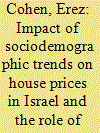

|
|
|
|
|
| Summary/Abstract |
This article examines the impact of sociodemographic trends in marriage, divorce, and rising life expectancy in different districts in Israel on the increase in the number of households and, in turn, on the rising house prices in each of the districts. The findings show that in 2008–17, the Tel Aviv, Jerusalem, and Central districts, which had higher marriage, divorce, and life expectancy rates compared to other districts not only had the largest annual increment in the total number of households but also saw a particularly steep rise in house prices compared to a more moderate rise in the other districts and outlying areas. This state of affairs requires the formulation of a public policy capable of influencing demand and supply pressures in the house market in the various districts, with the aim of regulating house prices in accordance with national needs and government strategies for spreading the population throughout the country.
|
|
|
|
|
|
|
|
|
|
|
|
|
|
|
|
| 13 |
ID:
106134


|
|
|
| 14 |
ID:
112378


|
|
|
|
|
| Publication |
2012.
|
| Summary/Abstract |
Despite recent legislation and regulations to protect homeowners' rights in the process of urbanization, forced eviction remains one of the most prevalent causes of violence in contemporary China. This article examines the capacity of residents of Chinese cities to protect their property rights using new media to produce alternative discourses on law in the urbanization process. Fieldwork conducted in Beijing from 2007 to 2008, a period during which the national capital underwent massive development schemes for the 2008 Summer Olympic Games, shows that homeowners create virtual precedents, backed not by the authority of the court, but by that of the media. Evictees of so-called dingzihu (nail-houses) facing chaiqian (demolition and relocation) develop arguments based on the 2007 case of Wu Ping, the first new media superstar in (post-)socialist China. The article, following post-structuralist formulations, develops a theory of 'legal surrealism' characteristic of the position of law in reform-era China. Whereas social media is equated with revolution elsewhere, in China, the lesson of the role of new media in effecting social change may be one of limitation. While digital mass communication technologies may assist individual 'victories', challenges to eviction face both intrinsic and extrinsic obstacles for collective action.
|
|
|
|
|
|
|
|
|
|
|
|
|
|
|
|
| 15 |
ID:
182894
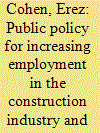

|
|
|
|
|
| Summary/Abstract |
This article examines public policy aimed at planning the domestic housing market and regulating employment in the construction industry, as formulated and implemented in Israel in light of the rapid rise in domestic housing prices. It shows that despite their awareness of the growing discrepancy between supply and demand and its impact on housing prices, policymakers acted mainly to suppress the demand instead of speeding up the pace of construction so as to increase the supply of houses. The article concludes with a number of recommendations of ways to increase the number of workers in the construction industry as a means to reducing housing prices.
|
|
|
|
|
|
|
|
|
|
|
|
|
|
|
|
| 16 |
ID:
158152


|
|
|
|
|
| Summary/Abstract |
The conspicuous rise in Israel’s housing prices from 2008 to date, after the stable prices in the early 2000s, has raised concerns of a property bubble in the Israeli economy. The grave effects of real estate bubbles that emerged in various countries around the world throughout history and led to severe long-term economic crises within the country and elsewhere add to the concern about such occurrences in the Israeli economy. This article focuses on the current effects of the real estate bubble on Israeli society at the preliminary stage, and examines the sociodemographic implications of Israel’s rise in housing prices and its impact on several social parameters, such as the average number of members in a household, Israel’s residential density, age at marriage, the extent of emigration from the country among the young, the population’s spread to peripheral areas, the inequality index, and more.
|
|
|
|
|
|
|
|
|
|
|
|
|
|
|
|
| 17 |
ID:
169357
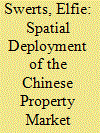

|
|
|
|
|
| Summary/Abstract |
Real estate activities and companies in China have grown considerably since the major reforms of the late 1970s. This paper examines the spatial deployment of firms linked to the Chinese real estate market in Chinese cities in 2010, 2013 and 2016. It provides a first mapping of multinational firms specialized in the real estate sector. It describes the patterns of ownership networks built by financial links both between foreign multinational firms and Chinese firms and among multinational firms themselves. It therefore provides a new understanding about the penetration of both foreign direct investment (FDI) and Hong Kong’s role in the Chinese real estate market. This paper provides a comparison of the spatial location logics of these firms according to their Chinese or foreign origin and offers a new perspective on the geography of real estate investment by analyzing financial links between the Chinese and foreign cities involved.
|
|
|
|
|
|
|
|
|
|
|
|
|
|
|
|
|
|
|
|
|